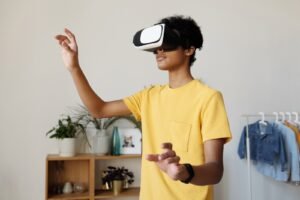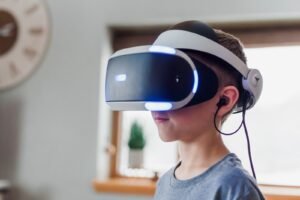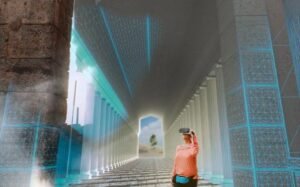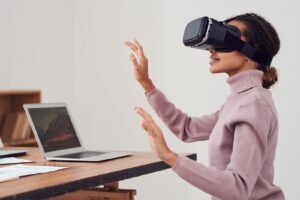Discover the benefits of immersive learning brought to you by Augment Explorer, an innovational education VR company, which offers interactive and immersive learning experiences.
Immersive learning is revolutionising standard teaching strategies in this ever-changing digital world. Virtual reality (VR) and augmented reality (AR) technology enable teachers to design engaging, interactive lessons that capture students’ attention like never before.
Immersive learning offers an unmatched level of engagement and experiential learning, whether it’s studying ancient civilisations, performing digital science experiments, or practising real-world simulations.
Thanks to the technological advancements of AR and VR, immersive learning also enhances critical thinking, problem-solving, and information retention, according to research. It fosters student collaboration and innovation. Students can actively engage in their own learning process by being placed in realistic and immersive situations.
Immersive learning needs to be embraced as the landscape of education changes. Join us as we examine the countless opportunities it presents and the radical changes it has brought about in education. Prepare to enter a new era of education!
How does immersive learning work?
Virtual reality (VR) and augmented reality (AR) technologies are used in immersive learning to create dynamic and interesting learning experiences. It gives students the chance to fully immerse themselves in situations that are both realistic and immersive, allowing for a practical and experiential learning style. It is a very effective approach of education since students actively engage in their own learning process rather than passively absorbing knowledge.
Virtual field trips, interactive simulations, and virtual labs are a few examples of immersive learning formats. Students can visit many places, times, and scenarios with VR goggles, making learning more engaging and memorable. Contrarily, augmented reality (AR) superimposes digital data onto the physical world to improve learning by incorporating interactive features and visualisations.
Because these technologies are immersive, students can use all their senses and feel present, which enhances the learning process and makes it more lasting. Traditional teaching techniques just cannot compete with the level of interaction and realism it offers.
It is vital to have access to the required technology and software, as well as to provide training to both teachers and students, to implement immersive learning in the classroom. Immersive learning is becoming more and more viable for educational institutions of all sizes, though, as technology becomes more widely available and more reasonably priced.
Benefits of immersive learning for students
Immersive learning and VR education offer a wide range of benefit, which significantly improve the educational experience for students and teachers. These advantages extend to numerous areas of learning and development and go beyond basic participation.
1. Increased memory retention
Improved information retention is one of the main benefits of immersive learning. Students’ brains are more likely to encode and retain knowledge when they are exposed to realistic and interactive situations. Studies have demonstrated that immersive learning can result in higher levels of knowledge retention and recall when compared to conventional learning techniques.
2. Improved capacity for critical thinking
Through hands-on, interactive learning, students are encouraged to think critically and solve challenges. Students are forced to do information analysis and evaluation, make decisions, and use their knowledge to resolve issues by being presented with real-life scenarios and difficulties. Through their active participation, students are able to gain a deeper comprehension of the subject matter and strengthen their critical thinking abilities.
3. Enhanced creativity and teamwork
Students get the chance to be creative and work with their peers in immersive learning environments. Students can develop their creative potential in a secure and encouraging atmosphere by designing virtual constructions, running experiments, or developing immersive storytelling experiences. Additionally, group projects and activities promote collaboration by letting students work together and gain insight from one another’s viewpoints.
4. Experiential and practical learning
Giving students access to practical and hands-on learning opportunities is one of immersive learning’s most important advantages. For instance, students can visit virtual recreations of historical landmarks and engage with virtual characters from that era in place of reading about ancient civilisations in a textbook. Students can have a deeper grasp and enjoyment of the subject matter thanks to this immersive and hands-on teaching method.
5. Individualised and flexible learning
Each student’s unique demands and learning preferences can be catered for in an immersive learning environment. Using analytics and adaptive algorithms, educators can keep tabs on students’ development and customise the learning process to suit their individual needs. The correct amount of challenge and support are provided to pupils thanks to this personalised method, maximising their learning potential.
6. Improved engagement through interactive learning
The potential of immersive learning to motivate and engage s may be one of its most obvious advantages. Students’ attention is captured and learning is made more fun by the interactive and immersive character of the technology. Students are more likely to take an active role in their education, which increases motivation and raises academic accomplishment.
Statistics on immersive learning
Immersive learning has a significant positive impact on the educational sector, which is backed by several creditable studies, research and data. Empirical studies and research show how immersive learning has a revolutionary effect on education and the benefits it may provide for students.
A few of the compelling studies and research projects are shared below:
- According to research from the University of Maryland, students who learnt through immersive VR experiences had better spatial learning and problem-solving skills than those who used more conventional teaching techniques.
- A recent Stanford University research project found that students who learned through immersive VR experiences had significantly higher levels of knowledge retention than those who learned using more conventional techniques.
- According to research published in the Journal of Science Education and Technology, students who utilised immersive VR simulations for science experiments outperformed their peers who used conventional methods.
- In a recent Microsoft poll, 93% of teachers said that immersive learning technology increased student enthusiasm and engagement.
- A commercial research study conducted by Goldman Sachs predicts that by 2025, the global market for VR in education will be worth USD$700 million, demonstrating the growing interest in and investment in immersive learning technology.
Types of immersive learning technologies
A variety of technologies that can be used to create dynamic and interesting learning experiences are included in immersive learning experience. Some of the most popular immersive learning systems are listed below:
- Virtual Reality (VR)
Through the use of virtual reality (VR) technology, people can experience and interact with a virtual world in a simulated environment. Students can explore various settings, scenarios, and ideas while fully engaged in a digital environment by donning a VR headset. Virtual reality (VR) can be utilised for historical recreations, scientific simulations, and more.
- Augmented Reality (AR)
The use of augmented reality (AR) technology, which can be accessed through mobile devices, tablets, or AR glasses and allows students to interact with virtual objects and characters while in their physical environment, improves learning by adding interactive elements and visualisations. Interactive storytelling, instructional activities, and real-time data visualisation are all possible with augmented reality.
- Mixed Reality (MR)
AR and VR components are combined in Mixed Reality (MR) to produce a hybrid experience that fuses the real and virtual worlds. MR technology makes it possible for students to interact with digital characters and things while still being in their actual environment, making it perfect for interactive experiments, group projects, and hands-on simulations.
4. Virtual Tours and 360-Degree Videos
Virtual tours and 360-degree films offer students a panoramic picture of many settings and locales. Students can experience historical sites, museums, natural ecosystems, and more utilising VR headsets or mobile devices. By enabling realistic and interesting virtual field trips, this technology opens up the world to the classroom.
These immersive learning experience technologies give teachers a wide variety of tools and resources to design engaging lessons. By utilising these tools, instructors can engage students in fresh and fun ways, improving accessibility and enjoyment of learning.
Immersive learning strategies in the classroom
Planning and thought must go into implementing immersive learning in the classroom. To successfully incorporate immersive learning into your educational setting, follow these crucial steps:
1. Establish precise learning goals
It’s crucial to determine the precise learning goals you wish to accomplish before implementing immersive learning technology. Analyse how immersive learning experience can improve the educational experience and how to integrate it with your curricular objectives. You can make sure that immersive learning is used as a tool to promote and improve learning outcomes by establishing defined objectives.
2. Pick the right immersive learning tools.
Select the immersive learning technologies that best meet your instructional goals and your students’ needs. Think about things like the material you want to convey, the desired level of interaction, and the resources available. Make informed selections by conducting in-depth study and asking for advice from educators who have expertise using immersive learning technologies.
3. Give educators support and training
Teachers must have the essential knowledge and abilities to apply immersive learning successfully. Give teachers the chance to receive training and opportunities for professional development so they are conversant with the chosen immersive learning technologies. This will enable them to maximise the advantages of immersive learning and incorporate it into their teaching practises.
4. Produce informative and entertaining content
Create or gather content for immersive learning that is in line with your curriculum and learning goals. Make engaging experiences that encourage students to actively engage with the subject matter and put their learning to use. To improve the learning experience, take into account using gamification components, storytelling strategies, and collaborative activities.
5. Examine and assess the results
Assess the effects of immersive learning on the learning outcomes of students on a regular basis. Obtain student and teacher feedback to gain understanding of the value of immersive learning and pinpoint areas for development. Track student progress using data analytics and evaluation tools, and change the learning environment as necessary.
You may successfully deploy immersive learning experience in your classroom and realise all of its educational benefits by following these steps.
Conclusion
The potential for immersive learning experience grows as technology develops. Immersive technology have the potential to further improve educational experiences in the future. With immersive learning powered by augmented and virtual reality, the possibilities to develop new knowledge and skills are endless.
Get ready to unleash your imagination and witness firsthand the power of this cutting-edge technology!
Augment Explorer, is a leading educational technology company, which offers immersive learning experiences by using AR and VR. Check out our Blogs page for more news and updates about immersive learning.






